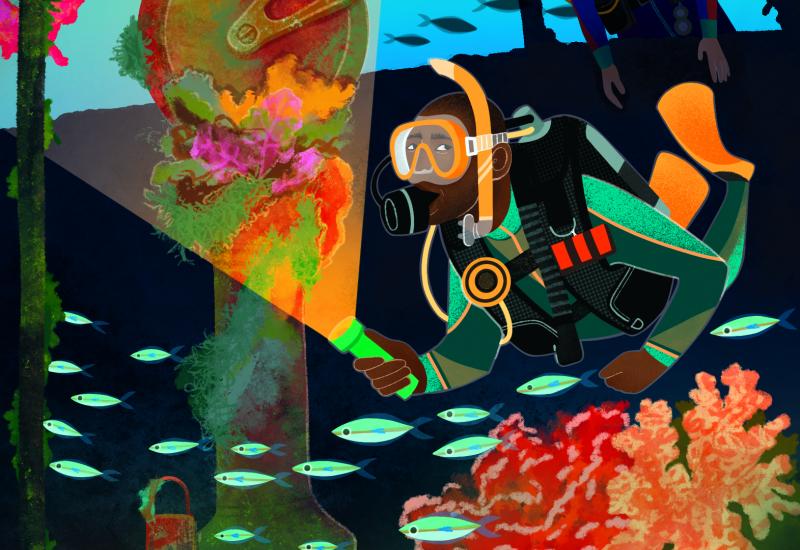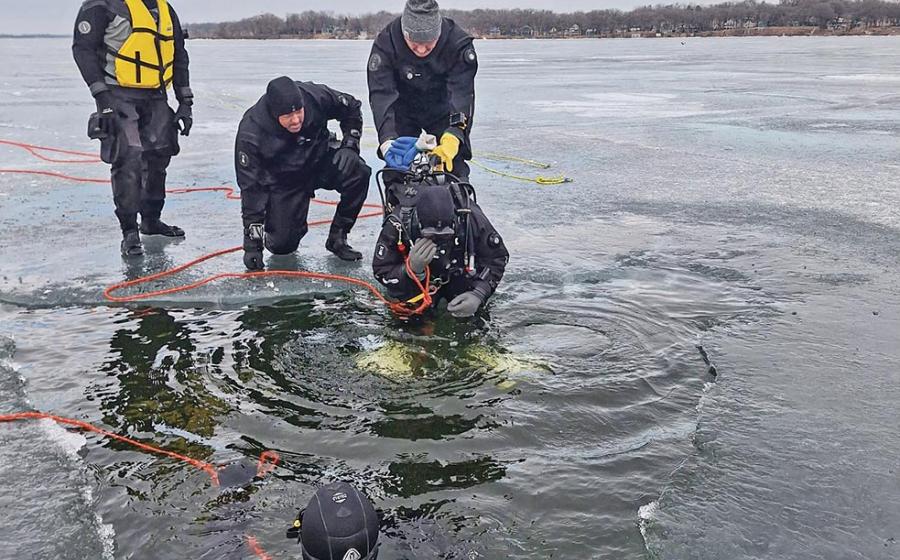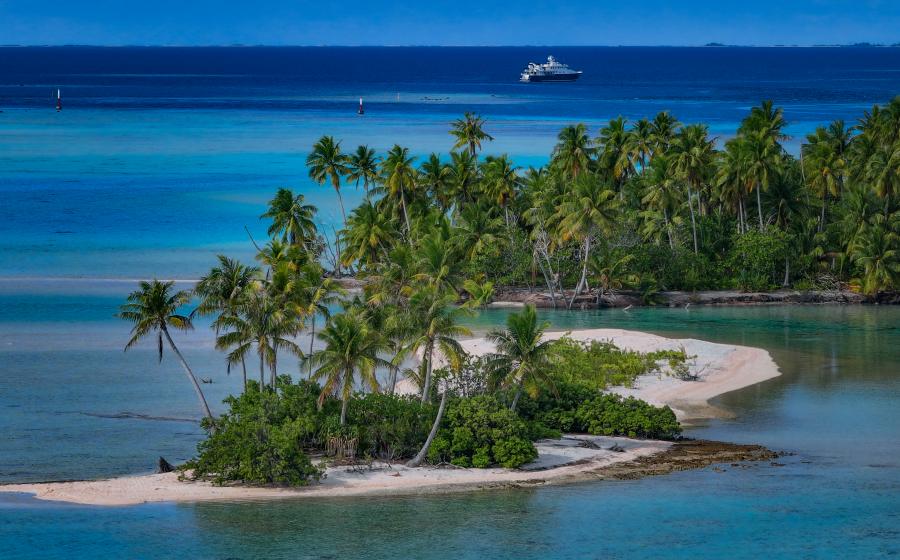Lake Champlain

April 2008
By Erik Sherman
Photography by Ethan Gordon

As I gently drift with the movement of Lake Champlain's currents, I come within arm's reach of the General Butler, a canal schooner that last felt the air in 1876. In 40 feet of water just off the rocky breakwaters near the Burlington, Vt., docks, the vessel is remarkably preserved--the Butler's sailing hardware, including its windlass and cleats, is still in place. There's just enough water clarity to see the ship's old wooden hull covered with zebra mussels.
The water temperature is 63 degrees--practically balmy by Lake Champlain standards--on this mid-September afternoon. It's actually warm enough for a 7 millimeter wetsuit; only three months earlier, the water was 22 degrees colder with just 10-foot visibility.
A flat-bottomed cargo boat that was towed along canals, then fitted with a mast for sailing on the lake, the Butler sank in a winter storm in 1876. The crew of five jumped onto a long pile of rock and endured the life-threatening weather until a ship chandler and his son braved the gale to rescue the survivors.
Today, about 1,000 divers a year come to Lake Champlain between mid-June and October to dive historic wooden boats like the Butler and other vessels that were once the lifeblood of commerce between New York and Canada, before succumbing to the region's climactic vagaries. The Lake Champlain Maritime Museum has established the Lake Champlain Underwater Historic Preserve System, encompassing eight remarkable 19th-century wrecks.
Vessels nearly 200 years old are scattered throughout Lake Champlain's cold, fresh water. Removing artifacts from any of the sites is prohibited, and so is penetrating any of the wrecks. Because the wrecks are made of wood that has soaked for upward of two centuries, they are fragile. A wayward fin tip can actually gouge a ship's hull. Besides the Butler, here are four other must-dive wrecks in Lake Champlain.
O.J. Walker
This is another canal schooner, and it's best suited for intermediate to advanced divers. It rests at about 60 feet, below the level at which the zebra mussels thrive. The grayish planks are visible and part of the mast angles up from the deck. When it sank in an 1895 storm, the Walker spilled its cargo: literally tons of bricks. The bricks are still scattered on the lake bottom around the site, and a few--along with some roofing tiles--remain on the deck, as though waiting for someone to tidy and stack them.
Burlington Bay Horse Ferry
At a depth of 50 feet, this is the only remaining example of a once-popular boat design in which harnessed animals walking on a round platform would propel the vessel. The paddle blades are long gone, but the oak spokes and wheel hubs remain. Not much is known about the identity or history of this ship, so archaeologists continue their studies. This site has two sets of buoys and anchor pads, so divers doing this dive should be careful not to ascend the wrong line.
Phoenix
This is the world's oldest known steamboat wreck, and it's sitting on a slope with the bow in about 60 feet of water and the stern in 110. The depth and limited visibility make it appropriate for advanced divers. The 146-foot-long ship went down in 1819 when a fire--possibly set by a competing shipping company--broke out. Six people died as a result. Char is visible on the ends of the framing timbers, as are the iron rods that once kept the machinery in place and the hardware from the steering system.
Champlain II
Close to the New York shore, the Champlain II, another steamboat, was originally built to carry railroad cars between Vermont and New York. On a July night in 1875 the boat ran aground. As the story goes, the pilot on duty lost his bearings and a subsequent inquiry found he'd been taking morphine to treat a case of gout. The vessel is in 15 to 35 feet of water, so it's a good dive for beginners--or anyone who wants to see the 160 feet that remain of the ship.
Driving to Lake Champlain from Boston may seem like a haul, but once there, as you sink beneath the surface, you slip away from the city of Burlington and from time itself. The past is never far away, as you discover when the gloom dissolves into a sharpening image of a vessel caught in mid-voyage.
InDepth
Getting Around: From Boston, take I-90 (the Massachusetts Turnpike) to I-91 North to I-89 North to U.S. 2 West to Burlington, Vt. From New York City, take I-87 North to U.S. 4 East to Route 30 to U.S. 7 North to Burlington, Vt.
Dive Conditions: In June, water temps are in the low 50s, but by August, they can be in the low 70s. Expect thermoclines with temperatures dropping the deeper you descend. Visibility ranges from 20 to 35 feet. The standard suit for summer diving is a 7 mm wetsuit. Before diving the preserve, you must register for the season--free of charge--with a dive shop, charter boats, the Lake Champlain Maritime Museum or the Burlington Community Boat House. After each dive, soak gear in hot tap water before entering another body of water to avoid spreading the zebra mussel, an invasive and damaging species.
Dive Outfitters, Charters and Education Centers: Victory Sports, Colchester, Vt., www.victorysports.net; Waterfront Diving Center, Burlington, Vt., www.waterfrontdiving.com; Lake Champlain Maritime Museum, Vergennes, Vt., www.lcmm.org.

April 2008
By Erik Sherman
Photography by Ethan Gordon

As I gently drift with the movement of Lake Champlain's currents, I come within arm's reach of the General Butler, a canal schooner that last felt the air in 1876. In 40 feet of water just off the rocky breakwaters near the Burlington, Vt., docks, the vessel is remarkably preserved--the Butler's sailing hardware, including its windlass and cleats, is still in place. There's just enough water clarity to see the ship's old wooden hull covered with zebra mussels.
The water temperature is 63 degrees--practically balmy by Lake Champlain standards--on this mid-September afternoon. It's actually warm enough for a 7 millimeter wetsuit; only three months earlier, the water was 22 degrees colder with just 10-foot visibility.
A flat-bottomed cargo boat that was towed along canals, then fitted with a mast for sailing on the lake, the Butler sank in a winter storm in 1876. The crew of five jumped onto a long pile of rock and endured the life-threatening weather until a ship chandler and his son braved the gale to rescue the survivors.
Today, about 1,000 divers a year come to Lake Champlain between mid-June and October to dive historic wooden boats like the Butler and other vessels that were once the lifeblood of commerce between New York and Canada, before succumbing to the region's climactic vagaries. The Lake Champlain Maritime Museum has established the Lake Champlain Underwater Historic Preserve System, encompassing eight remarkable 19th-century wrecks.
Vessels nearly 200 years old are scattered throughout Lake Champlain's cold, fresh water. Removing artifacts from any of the sites is prohibited, and so is penetrating any of the wrecks. Because the wrecks are made of wood that has soaked for upward of two centuries, they are fragile. A wayward fin tip can actually gouge a ship's hull. Besides the Butler, here are four other must-dive wrecks in Lake Champlain.
O.J. Walker
This is another canal schooner, and it's best suited for intermediate to advanced divers. It rests at about 60 feet, below the level at which the zebra mussels thrive. The grayish planks are visible and part of the mast angles up from the deck. When it sank in an 1895 storm, the Walker spilled its cargo: literally tons of bricks. The bricks are still scattered on the lake bottom around the site, and a few--along with some roofing tiles--remain on the deck, as though waiting for someone to tidy and stack them.
Burlington Bay Horse Ferry
At a depth of 50 feet, this is the only remaining example of a once-popular boat design in which harnessed animals walking on a round platform would propel the vessel. The paddle blades are long gone, but the oak spokes and wheel hubs remain. Not much is known about the identity or history of this ship, so archaeologists continue their studies. This site has two sets of buoys and anchor pads, so divers doing this dive should be careful not to ascend the wrong line.
Phoenix
This is the world's oldest known steamboat wreck, and it's sitting on a slope with the bow in about 60 feet of water and the stern in 110. The depth and limited visibility make it appropriate for advanced divers. The 146-foot-long ship went down in 1819 when a fire--possibly set by a competing shipping company--broke out. Six people died as a result. Char is visible on the ends of the framing timbers, as are the iron rods that once kept the machinery in place and the hardware from the steering system.
Champlain II
Close to the New York shore, the Champlain II, another steamboat, was originally built to carry railroad cars between Vermont and New York. On a July night in 1875 the boat ran aground. As the story goes, the pilot on duty lost his bearings and a subsequent inquiry found he'd been taking morphine to treat a case of gout. The vessel is in 15 to 35 feet of water, so it's a good dive for beginners--or anyone who wants to see the 160 feet that remain of the ship.
Driving to Lake Champlain from Boston may seem like a haul, but once there, as you sink beneath the surface, you slip away from the city of Burlington and from time itself. The past is never far away, as you discover when the gloom dissolves into a sharpening image of a vessel caught in mid-voyage.
InDepth
Getting Around: From Boston, take I-90 (the Massachusetts Turnpike) to I-91 North to I-89 North to U.S. 2 West to Burlington, Vt. From New York City, take I-87 North to U.S. 4 East to Route 30 to U.S. 7 North to Burlington, Vt.
Dive Conditions: In June, water temps are in the low 50s, but by August, they can be in the low 70s. Expect thermoclines with temperatures dropping the deeper you descend. Visibility ranges from 20 to 35 feet. The standard suit for summer diving is a 7 mm wetsuit. Before diving the preserve, you must register for the season--free of charge--with a dive shop, charter boats, the Lake Champlain Maritime Museum or the Burlington Community Boat House. After each dive, soak gear in hot tap water before entering another body of water to avoid spreading the zebra mussel, an invasive and damaging species.
Dive Outfitters, Charters and Education Centers: Victory Sports, Colchester, Vt., www.victorysports.net; Waterfront Diving Center, Burlington, Vt., www.waterfrontdiving.com; Lake Champlain Maritime Museum, Vergennes, Vt., www.lcmm.org.










